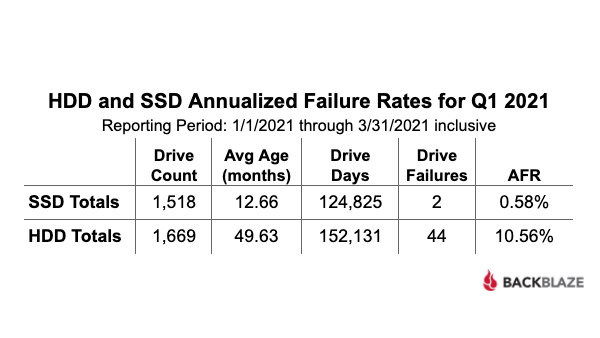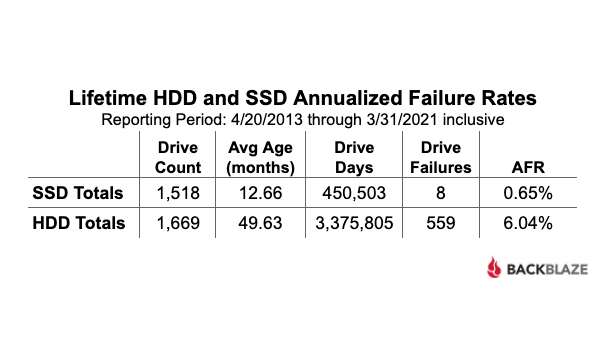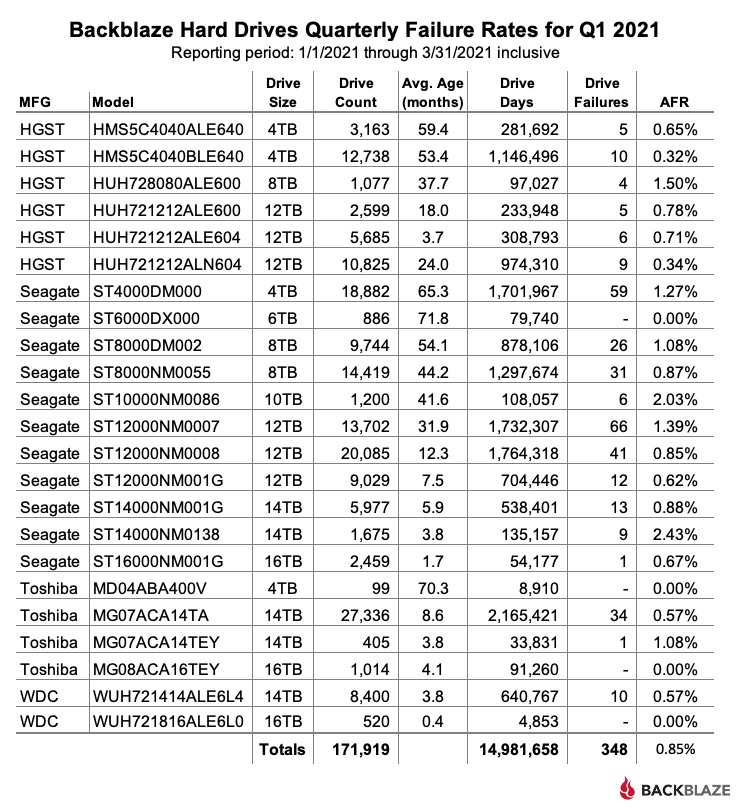Study Shows SSDs Are More Reliable than HDDs
If you needed another reason to get one of the best SSDs rather than any hard drive, here's one. Blackblaze, an online backup storage company, published a study showing that SSDs having a far lower failure rate than traditional hard drives. (HDDs). This data was taken from the servers in thousands of Blackblaze's data center servers over the past several years.
Blackblaze has been analyzing the reliability of its hard drives for years and has detailed graphics of which hard drives from WDC, Toshiba, Seagate and HGST are the most reliable and which ones are more prone to failures. But, this is the first time Blackblaze has started analyzing SSDs as well.
Keep in mind that the average age of the SSDs Backblaze uses is only 12.7 months old, whereas the average age of its hard drives is 4x older, 49.6 months to be precise. Also, Blackblaze uses SSDs as boot drives alone in its servers, so these SSDs could also have less of a workload compared to the actual hard drives where are constantly being used to backup client data.


Counting the annual failure rates of Blackblazes drives; all of the company's hard drives netted a failure rate of 10.56%, meanwhile, all SSDs netted just 0.58% in failure rates.
The excellent reliability of SSDs becomes even more apparent in the lifetime graph, where SSDs failure rates were just 0.65%. HDD failure rates were lower at 6.04%, but still not close to solid-state drives.

For hard drive model comparisons, Blackblaze shared with us a chart of all the hard drive models actively used in its servers. These range from HGST drives, to Seagate, Toshiba, and a couple of WDC drives.
Most notable are the Toshiba, Seagate, and WDC 16TB drives which so far have zero recorded losses. Some of HGST's 12TB and 4TB models also record extremely low losses of just 0.33% on average.
Get Tom's Hardware's best news and in-depth reviews, straight to your inbox.
Meanwhile, some of the least reliable drives are from Seagate alone, some of its 10TB, 12TB, 14TB and 4TB model's have record failure rates well above 1%, with the 10TB model and 14TB model been even worse with over a 2% failure rate.
For more details on Blackblaze's hard drive analytics, check out the company's latest report.

Aaron Klotz is a contributing writer for Tom’s Hardware, covering news related to computer hardware such as CPUs, and graphics cards.
-
g-unit1111 After converting my primary rigs to all M2, there's no way I'll ever go back to mechanical HDs.Reply
The only way I would buy a new mechanical HD is if I needed a storage capacity larger than 4TB. -
naughty_mage what idiot did the math on this article? "Counting the annual failure rates of Blackblazes drives; all of the company's hard drives netted a failure rate of 10.56% "Reply
Umm, 172k drives and a total failure count of 348 drives is not even a fraction of a percent. You don't total up all the average failure rate percentages of the drives, you take the total drives and divide by total failed drives. as they show at the bottom, 0.85 % not bloody 10+% geez. -
chaz_music Replynaughty_mage said:what idiot did the math on this article?
Had to laugh at the quote. This is very typical of misunderstood engineering math. But the number in the article is correct. The trick wording is "annual failure rate" and how you calculate that. In reliability statistics, this is called FIT rate.
The drive population in the study is 172K unit, but the population ** age** is much older than 12 months. The average HDD age in the study is 49.63 months but the average SSD age is only 12.7 months. They are calculating FIT rate (failures in time). By using their numbers, I calculated a slightly larger FIT than they did. With FIT rate, you can also approximate MTBF (mean time between failures).
Another note: Having spent a large portion of my career working with reliability, I always find it interesting that we miss the entire picture with "study bias". In this case, the design and failure modes are not being checked for any other possible differences that also are effecting the numbers. If most of these SSD were actually SATA and SAS type SSDs, those also have the nice feature that they are totally enclosed so the user does not touch the PCB.
In other words, the risk of ESD damage is much lower (static discharge).
Due to legacy HDD design structure and no industry interest to address the failure modes due to packaging, almost all rotating HDDs have their control PCB exposed. So the user / installer can inadvertanly touch it. ESD damage is VERY pervasive in the electronic industry and is considered the highest single failure mode other than user error.
If they parse the data into which SSDs are enclosed SATA/SAS versus open PCB M.2 types, they might actually see somthing very interesting. I would bet money that the M.2 SSD have a higher annual failure rate than SATA type SSDs. -
spongiemaster Reply
You're right, but it was still an idiot that wrote the article. The company is Backblaze, yet the article calls them Blackblaze every single time including the image credit to them.chaz_music said:Had to laugh at the quote. This is very typical of misunderstood engineering math. But the number in the article is correct. The trick wording is "annual failure rate" and how you calculate that. In reliability statistics, this is called FIT rate. -
Heat_Fan89 The article brings up a good point. How many of those SSD's are being used primarily as boot drives? If that's the case as the article points out the SSD should be more reliable. It would have been better to compare both the SSD's and HDD's under similar workloads to have a more accurate picture.Reply -
USAFRet Reply
In the context of Backblaze use, "boot drive" is not a thing.Heat_Fan89 said:The article brings up a good point. How many of those SSD's are being used primarily as boot drives? If that's the case as the article points out the SSD should be more reliable. It would have been better to compare both the SSD's and HDD's under similar workloads to have a more accurate picture. -
Makaveli My current rig is all flash and will never see a standard hard drive. Only the NAS on my network uses NAS optimized Hard drives.Reply -
USAFRet Reply
Same with my systems.Makaveli said:My current rig is all flash and will never see a standard hard drive. Only the NAS on my network uses NAS optimized Hard drives.
All SSD, except for what is in or attached to the NAS. -
watzupken I can agree to this fact that SSDs tend to be more reliable that HDD. At least based on my hardware experience over 2 decades, the switch to SSDs is probably the best thing that happened for PC. Not only does it make everything snappy and fast, I also don't experience that much of issues with HDD such as bad sector, need to defrag and failing drives over the last decade since my first SSD, the Intel X25 G2, which by the way is still alive and healthy despite being around 10 years old. HDD in the past can last for a long time, i.e. I have drives that lasted more than a decade, but current ones are quite crappy, especially the case if you are buying cheap ones. So the downward race to cut cost, accelerated the demise of HDD.Reply -
derekullo Blackblaze ... AmaterasuReply
Covering your hard drives in eternal black flames would get you that 10.56% failure rate :p